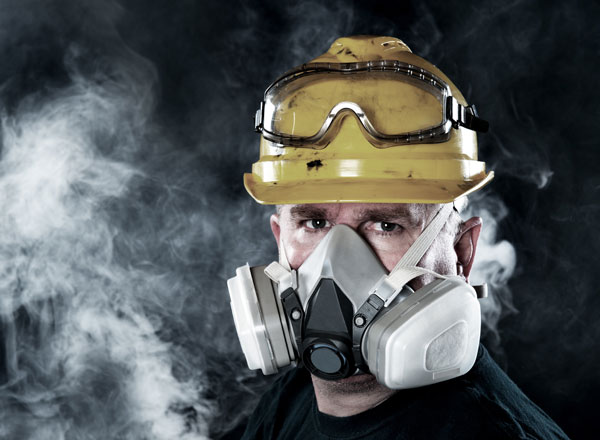Statistics show that every year a staggering 13,000 deaths each year are linked to past exposures at work, mainly to chemicals or dust, with occupational lung diseases accounting for around 12,000 deaths.
With a recent Labour Force Survey revealing there are around 20,000 new cases of breathing or lung problems caused or made worse by work each year, Bob Bradford, Chair of CECA National Health & Safety Forum addresses the continuing challenges of respiratory protection in the construction sector.
The topic of respiratory protection for any and all respiratory hazards is one which I have often found to be poorly understood and I have encountered numerous situations where workers have been left exposed to respiratory hazards, particularly dusts, resultant from the workplace or their tasks.
Respiratory disease and untimely death resulting from occupational exposure appears to be the single biggest issue facing civil engineering and construction as well as other industries, and society as a whole.
HSE published statistics indicate 12,000 Lung disease deaths each year estimated to be linked to past exposures at work. 60 % of these relating to conditions other than asbestos related.
The principles of prevention from Schedule 1 to the Management of Health and Safety at Work regulations should perhaps be leading us to be much more active in respect of respiratory hazards.
We are an inventive and innovative industry and there are no doubt many examples where processes have been altered to prevent the production of dust as well as significant reduction in potential exposure through the use of engineering controls such as water suppression or Local Exhaust Ventilation (LEV).
I perceive a growing understanding that all processes producing respiratory hazards must be subject to engineering controls such as water suppression or LEV. Where such engineering controls are demonstrated to not be fully effective, it may be necessary to supplement them with personal respiratory protective equipment (RPE).
It is in the area of selection, provision and use of RPE that I have most often encountered issues which result in workers not being adequately protected and most often where tight fitting facepieces have been the selection made by employers. This may be down to poor selection or lack of understanding on the part of employers, supervisors and workers.
I offer some of my views on why this may be and some considerations I believe should be made when choosing RPE.
Incorrect fitting or wearing of masks may allow the worker the perception of protection as they are not breathing in the larger particles which would cause coughing or sneezing or get caught in the mucus of the nose, mouth and throat. These natural body defences are not triggered by the smaller (respirable) components which can get deep into the lung and ultimately cause damage.
It appears the same perception of protection occurs when RPE wearers have not been clean shaven. All tight fitting RPE (reusable or disposable) relies upon an effective seal with the wearer’s face and is therefore reliant on the user being clean shaven (defined as within the 8 hours preceding the donning of the mask).
Whilst I am aware of statements in respect of reg. 7 of the H&S at Work Act requiring employees to co-operate with their employer, I do not believe it to be possible to successfully use this or other H&S legislation to require or force a worker to be clean shaven.
The reg. 7 requirement is for workers to co-operate and comply with a statutory obligation placed upon the employer. There is no ‘statutory obligation’ for the worker to be altered to suit the work or equipment.
The PPE regulations require that all protective equipment must be matched to, or adjustable to suit the ergonomic requirements of the individual wearer / user. The differences in facial characteristics between individuals, genders and / or races mean that there can be no ‘one size fits all’.
The requirement for adjustment to fit is placed on the equipment not the individual.
Other legislation such as the Equality Act provides rights for religious observation which can include the wearing of facial hair. Employers are required to either remove that individual from the hazardous environment, which may in turn represent discrimination. Or, they should provide RPE which does not rely upon a tight seal with the face.
This may also have relevance in respect of the Human Rights act and the right to a private life. An individual is not obliged to inform their employer if they follow a religion nor indeed if they are wearing facial hair as a result of a religious observation.
Whilst I am not aware of case law, I believe it would represent a breach of legislation on the part of the employer, and potentially a supervisor, if a worker was permitted or required to wear a tight fitting mask when they would not be protected, e.g. due to not being clean shaven.
Where workers have been contractually required, or have agreed, to be clean shaven and the employer may have agreed to or facilitated shaving in the workplace, consideration would be required for the disposal of potentially contaminated waste (sharps).
Any cuts sustained from shaving with a blade in the workplace will be an injury accident in the workplace and should be recorded as such. Any cut in the area of the face seal should be allowed to heal prior to wearing a tight fitting mask.
The aspect of face fit and correct use is complex to achieve effective, and ongoing, protection and must not be oversimplified.
The exact type and model of tight fitting mask in use must have been tested to prove its effectiveness for each individual wearer and repeated at intervals or if the wearer’s facial characteristics change.
The wearer is restricted to using only the make and model of tight fitting mask that has been demonstrated by testing as being effective in protecting them.
Testing is carried out quantitatively by Portacount or qualitatively using bitrex or saccharin solution. Either means of testing must have been carried out by a competent tester. The British Safety Industry Federation (BSiF) has worked with stakeholders and the HSE to develop an accreditation for fit2fit testers which is recognised by the HSE as demonstrating good practice.
The use of tight fitting RPE is limited, by HSE published guidance, to 1 hour continuous use. This in recognition that wearing a mask suitably tight is uncomfortable as well as placing restriction on the breathing of the wearer – their lungs having to pull air through the filter media. Both factors can lead to the loosening or moving of the mask for comfort or to make breathing easier. The net effect being that the worker is not as protected as they should be.
There is no time period defined for how long before a tight fitting mask can be worn again but if a mask is to be reused it needs to be stored hygienically between uses.
In considering RPE choices for workers a comparison should be made of the initial outlay cost, initial and ongoing / repeat testing, maintenance, supervision and monitoring.
A cost benefit exercise carried out in 2009 showed that the ongoing cost of disposable tight fitting RPE and associated management was around £2,800 per annum per individual.
A more simplistic cost comparison I carried out some years ago showed that the catalogue advertised price of approx. 169 mid-priced disposable FFP3 masks represented the same outlay cost as a powered respirator helmet set. If a worker was being issued a disposable mask a day the outlay cost of the powered system was reached in around two thirds of the year.
I consider it is a very positive step where employers have mandated loose fitting respiratory protection (powered or supplied air helmets and hoods) for respiratory hazards such as RCS, wood dusts and general construction dust.
Bob Bradford CFIOSH FInstLM
Chair, CECA National H&S Forum
Time and date
CONSTRUCTION DIRECTORY
Latest Construction News
26/11/2024
Scottish Water has unveiled its largest-ever procurement initiative, aiming to modernise the nation's water and wastewater infrastructure while safeguarding the environment. The program, named Delivery Vehicle 4, is valued between £5 billion and £9 billion and is set to run from 2027 to 2033, with ...
26/11/2024
The City of Edinburgh Council has granted planning permission, subject to conditions, for the refurbishment of Calton Square, an office building currently occupied by Baillie Gifford until the end of December 2025. Promoted by Ardstone Capital on behalf of Manova Partners, the project aims to ...
26/11/2024
First Minister John Swinney, MSP for Perthshire North, praised the progress being made on the construction of the new Perth High School during a visit on Friday, 22 November. He was joined by Jim Fairlie, MSP for Perthshire South and Kinross-shire, alongside senior Perth and Kinross Councillors, ...
26/11/2024
A state-of-the-art playpark has officially opened at King George V Park in Bearsden, following the completion of a £100,000 refurbishment. Funded by a combination of East Dunbartonshire Council (EDC) Capital Funding and the Scottish Government’s Renewing Scotland’s Play Parks initiative, the ...
26/11/2024
Fife Council has launched a public consultation, inviting residents, businesses, and organizations to contribute ideas and propose sites for inclusion in the next Local Development Plan, known as Fife's Place Plan. The council is calling on community councils, landowners, and developers to share ...
26/11/2024
The Chief Executive of East Lothian Council has announced she is to retire in February 2025. Monica Patterson who has been Chief Executive for almost five years, has spent most of her professional career working in local government. Prior to joining East Lothian Council in 2010, she was Head of ...
25/11/2024
West of Scotland Housing Association (WSHA) and Connect Modular have jointly submitted a planning application to Glasgow City Council for the development of 33 affordable homes in Cowlairs. This project aligns with the wider Cowlairs Park regeneration scheme and the city's ambitious housing ...
25/11/2024
Arc-Tech (Scotland) has successfully completed a £6m Mechanical and Electrical (M&E) services package for the Lost Shore Surf Resort in Edinburgh. The state-of-the-art resort, which opened its doors earlier this month, features a range of amenities, including a wave pool, luxury lodges, and ...
25/11/2024
Scottish Water has successfully completed the construction of a groundbreaking hydro energy generation scheme at Whiteadder Reservoir in East Lothian. This innovative project, believed to be the first of its kind in Europe, will harness the power of water to offset a significant portion of the ...
25/11/2024
Work is set to commence on a £6.5 million project to upgrade the Double Dykes Gypsy/Traveller site near Perth. The initiative aims to replace outdated chalets with modern, energy-efficient accommodation and implement significant site improvements. Perth & Kinross Council secured £3.9 million from ...


















